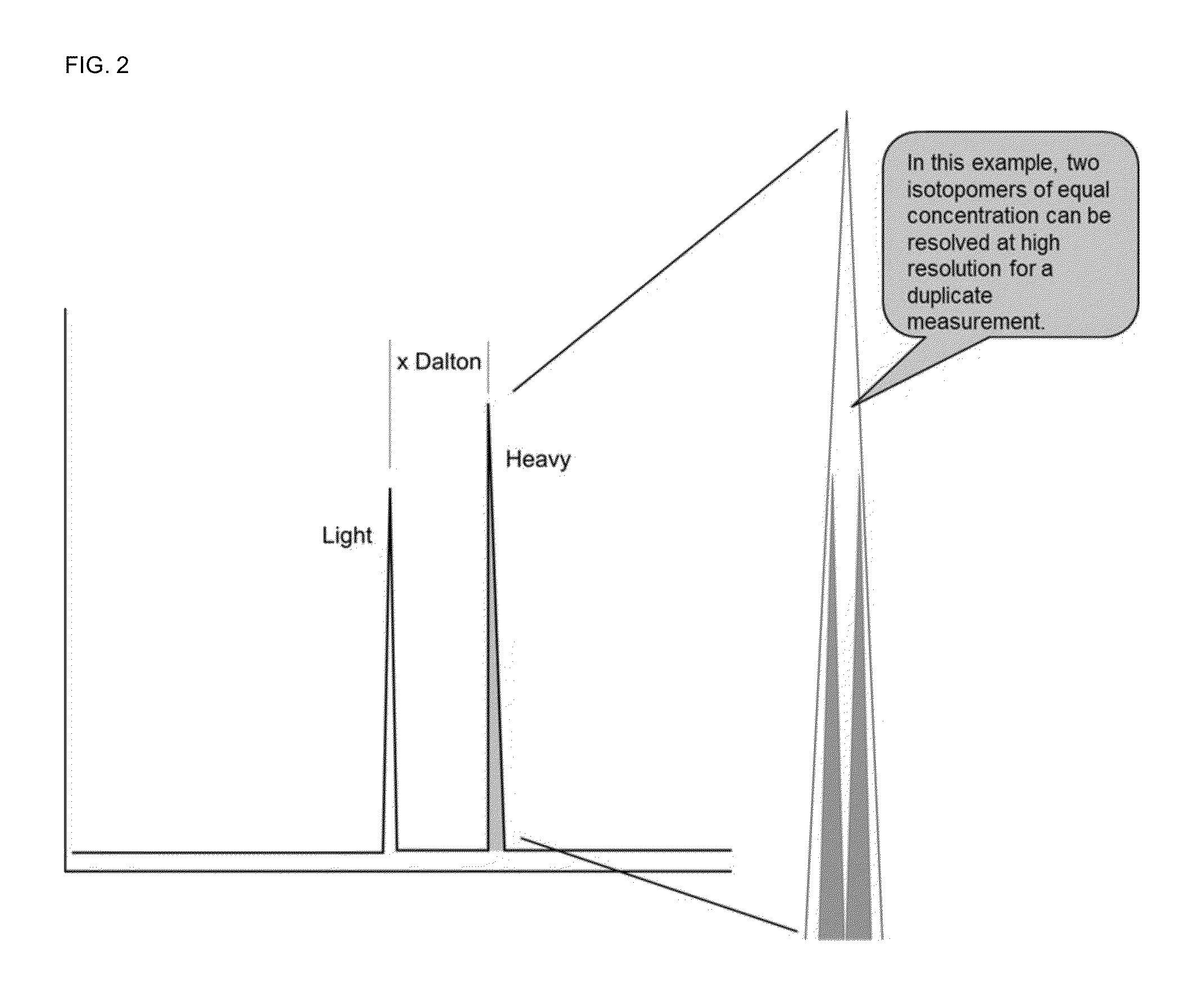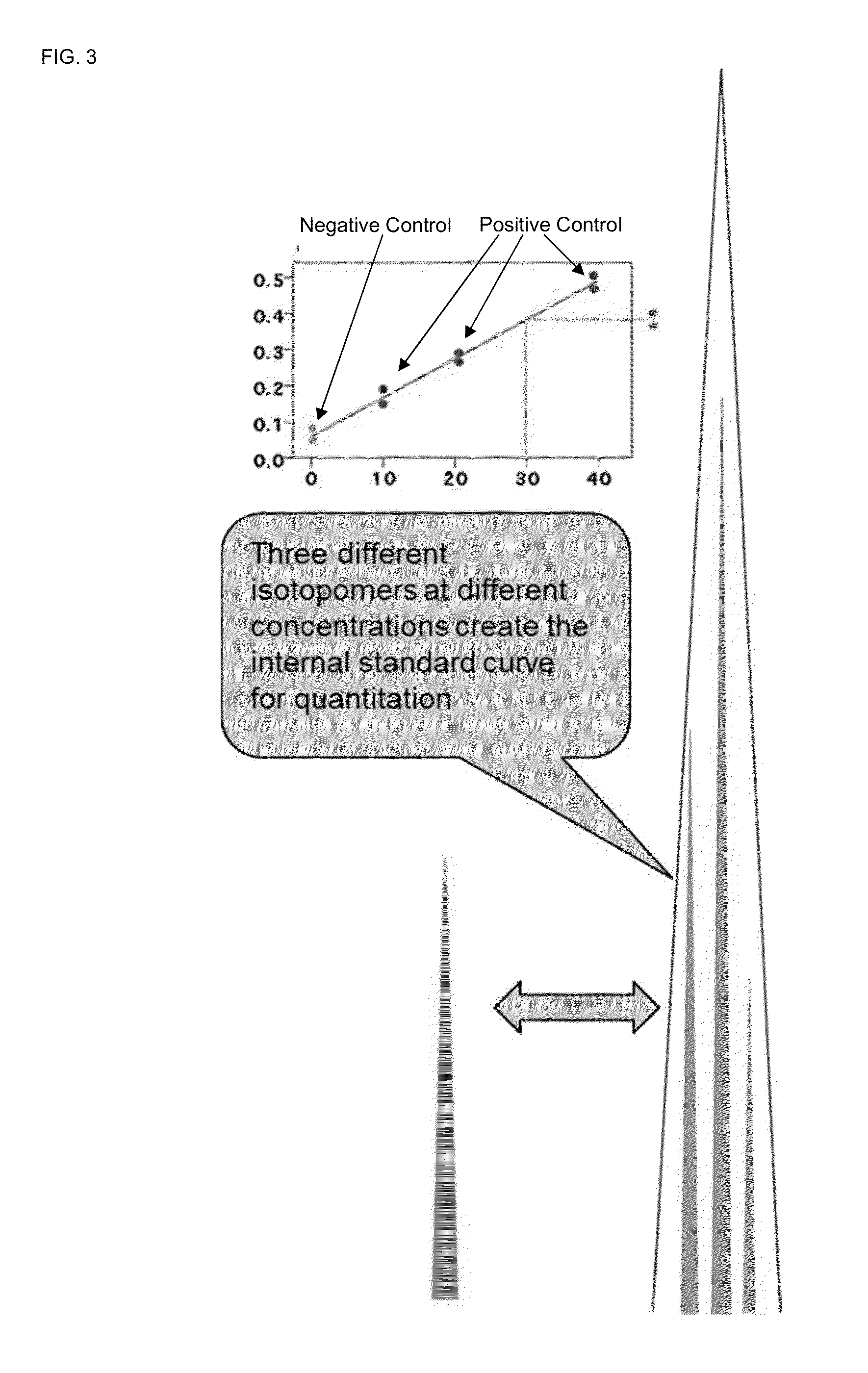Absolute quantitation of proteins and protein modifications by mass spectrometry with multiplexed internal standards
a mass spectrometry and internal standard technology, applied in the field of absolute quantitation of proteins and protein modifications, can solve the problems of heavy peptides with different mass defects and heavy peptides with mass defects, and achieve the effect of enhancing accuracy and/or sensitivity
- Summary
- Abstract
- Description
- Claims
- Application Information
AI Technical Summary
Benefits of technology
Problems solved by technology
Method used
Image
Examples
example 2
[0179]Stable isotopologue labeled peptides containing a universal reporter peptide R and several concatenated targeted analyte peptides are used to detect and quantify protein biomarkers in clinical samples, with a focus on markers of bladder cancer.
[0180]Exogenous proteins from yeast (Saccharomyces cerevisiae) (ADH, enolase, and carboxypeptidase) and human (LDH, NSE, Myo) are added as internal standards in urine samples. The isotopologue labeled synthetic polypeptide standards, which are proteotypic peptides of the protein of interest concatenated with a universal reporter peptide R, are spiked before proteolysis. Urine samples are prepared by protein precipitation, reduction / alkylation, trypsin proteolysis, and desalting using C18 cartridges. A second set of isotopically labeled synthetic peptides is added after proteolysis.
[0181]LC-MS / MS analyses are performed on RP-HPLC (Dionex) coupled with a hybrid high resolution MS instrument (Q Exactive, ThermoFisher Scientific) operated in...
example 3
[0184]To further evidence the method's utility, large synthetic polypeptides are produced, resulting from concatenation of multiple peptides representing each of the proteins of interest.
[0185]Three proteotypic peptides per protein with adequate mass spectrometric properties (precursor m / z, ionization efficiency, retention time, MS / MS spectra) are selected to construct the concatenated standards. These reference polypeptides, all containing a universal reporter, allow measurement of the precise amount of multiple reference peptides in one LC-MS run.
example 4
[0186]The inventive method decreases peptide synthesis cost and mass spectrometry usage to generate a calibration curve, resulting in savings in instrument usage, operator time, and processing efficiency. To further reduce the cost of peptide synthesis, one internal standard peptide is synthesized with no heavy isotope, and this peptide is labeled with a set of six amine-reactive triazine-based mass tag reagent isotopologues premixed at two-fold step dilution ratios (e.g. 4:2:1:0.5:0.25:0.0125). In preparing a calibration curve, these different tagged peptide concentrations are prepared in one labeling step with the pre-mixed isotopologue reagents and resolved in the LC-MS system with high resolution MS. A typical calibration curve requires six peptide injections at different peptide concentrations, but the disclosed AQUAplex tag approach described here reduces this to one injection. Each injection is performed in triplicate (three replicates). The total LC-MS analysis to generate a...
PUM
| Property | Measurement | Unit |
|---|---|---|
| mass | aaaaa | aaaaa |
| mass | aaaaa | aaaaa |
| mass | aaaaa | aaaaa |
Abstract
Description
Claims
Application Information
 Login to View More
Login to View More - R&D
- Intellectual Property
- Life Sciences
- Materials
- Tech Scout
- Unparalleled Data Quality
- Higher Quality Content
- 60% Fewer Hallucinations
Browse by: Latest US Patents, China's latest patents, Technical Efficacy Thesaurus, Application Domain, Technology Topic, Popular Technical Reports.
© 2025 PatSnap. All rights reserved.Legal|Privacy policy|Modern Slavery Act Transparency Statement|Sitemap|About US| Contact US: help@patsnap.com



